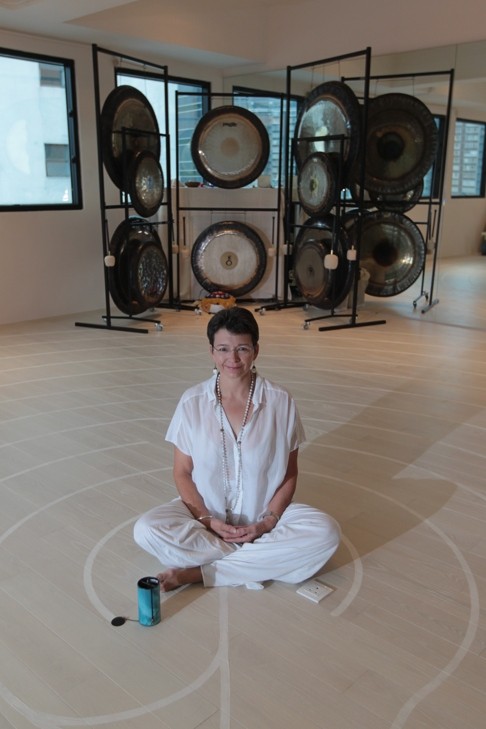
For Hongkongers who feel life is going too fast, walking a labyrinth can help
Viewed by some as a metaphor for life, negotiating a labyrinth is akin to walking meditation

Wellness coach and former trainer Martha Collard has created a large labyrinth in her studio. A circuitous route painted in white on the bleached wood floor of the Wong Chuk Hang space, it’s nothing like popular perception.
Many people equate labyrinths with mazes because both involve complex pathways. But whereas mazes are puzzles with numerous dead ends, branches requiring decisions on which way to take and perhaps multiple entry and exit points, labyrinths are made from a single path.

Although labyrinths also feature many twists and turns, they form a single, non-branching route that leads to the centre and back out again. The point is the journey, which is meant to encourage inner reflection.
“I want to have these labyrinths on every street corner because they’re a great way to destress,” says Collard, one of the few people in Asia who makes labyrinths.
According to Collard, no one is sure when the first labyrinths were designed nor who made them, but some date back 6,000 years and can be found in places from Greece to Sweden, and India to Indonesia.
“When you walk in a tight path, your mind calms down, and that’s how you can get inspiration and solutions because the brain is in neutral,” she says.
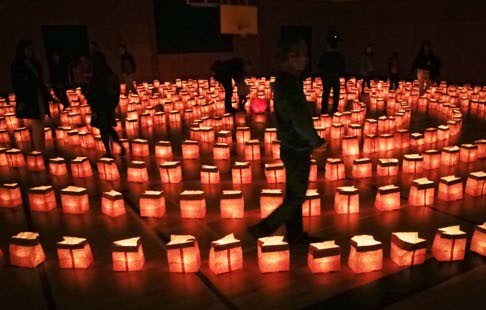
A medieval-style labyrinth typically features four quadrants, each representing one of the four seasons, and within each quadrant there are seven turns for each day of the week. However, there are a range of other classical styles, some similar to a seven-circuit pattern first recorded on an ancient Greek tablet, and others in three-fold seed designs such as the chakravyuha pattern found in India or the wheel patterns found around the Baltic shores.
Before proceeding into a labyrinth, users should have an intention or a question to meditate on.
“It’s a kind of walking meditation, so if you’re not good at sitting still and meditating, this is the next best thing,” Collard explains.
More than one person can walk the labyrinth at the same time and some people do it blindfolded, led by a guide.
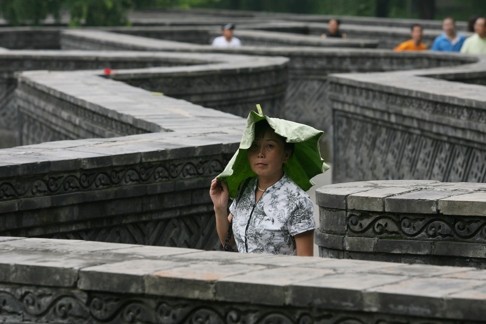
There are no set rules, except to enjoy the journey, which Collard describes as a metaphor for life. “Some people have emotional outbursts when they walk the labyrinth. Like some yoga poses, it’s a form of release,” she says.
She has made labyrinths to help different groups of people, from patients at Maggie’s Cancer Healing Centre to students at Hong Kong International School. The calming effect of tracing that path has benefited people going through divorce or bereavement as well as children with autism and ADHD.
Chartres Cathedral in France holds one of the most famous examples. Located in the nave, the pavement labyrinth was built in the late 13th century and is believed to have been used by Christian pilgrims. Those unable to make the long journey to Jerusalem, the holy city regarded as the centre of Christendom, would travel to the most important churches such as the cathedral in Chartres, where they would end their pilgrimage by walking the path in and out of the labyrinth.
In North America, there are labyrinths in schools, hospitals, hospices, community centres and churches.
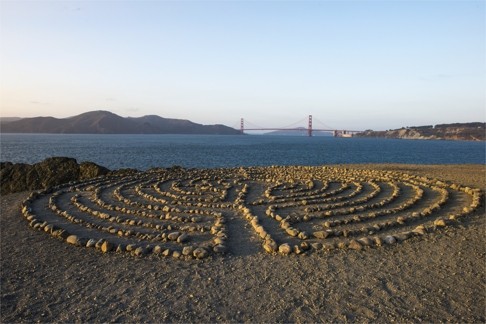
“Every office space has art – why not a labyrinth?” asks Collard, previously vice-president of group organisational wellness at Lane Crawford Joyce Group.
She has since founded her own wellness centre, Red Door Studio, which uses methods such as sound healing (with gongs), walking meditation (with labyrinths) and yoga to calm the body, mind and spirit.
Her goal is to help Hongkongers slow down and reflect on their lives.
Collard has approached churches and government departments about installing labyrinths in their public places, but only a handful of places expressed interest.
The Star Ferry was among the few: Collard inscribed a labyrinth on the ground floor near Pier 9 in 2010 and repainted it in October.
“A labyrinth changes the energy of a place. Every culture has a tradition of walking in a circle, like aboriginals in a pow wow, and Africans dancing in circles.
“The world is [going] too fast and we need ways to slow down,” Collard says. “I work with executives who are stressed out but don’t want to admit it. Many of them have depression. People need help but don’t know how to ask for it. Walking labyrinths is a good place to start.”
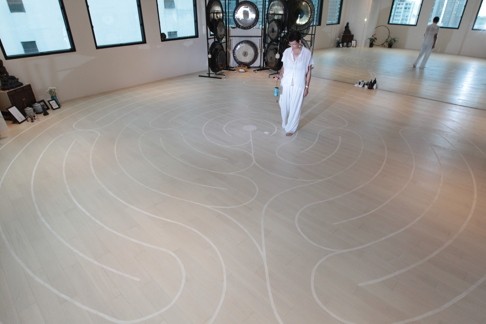
Ananya Jain, 15, and Nicky Yang Hsin-pei, 16, weren’t sure what to expect of the activity but as they continued along the path, the students began to realise how distracted their minds were. By having to focus on the labyrinth, they were able to clear their minds and be in the moment.
Nicky reports feeling more refreshed afterwards, but it took Ananya several attempts to complete the path.
The first two times, she was so distracted she couldn’t reach the centre. “There are so many twists and turns you have to focus. But Martha suggested I walk blindfolded with someone and trust them.”
Before walking the labyrinth, the 15-year-old had been wrestling with a niggling sense of discontent.
“I have everything – family, money, good education and friends, but I still felt incomplete and wondered why I always felt like that,” Ananya says.
The exercise helped her realise that the barrier to her happiness is the mistrust of people that she had built up, partly because of having to relocate cities several times since she and her family left India when she was seven years old.
“Since then I’ve been trying to not make a big deal about petty things… I feel more relaxed and it’s a relief,” she says.
The students’ humanities teacher, Marty Schmidt, says he gets his classes to walk the labyrinth once a term in the context of self-discovery.
“When you’re 16, 17 years old, you are trying to find your way in life. [Students] get mixed messages from their parents and friends. We do different spiritual practices such as meditation, journaling and walking the labyrinth, which combines the body, mind and heart. It’s a powerful symbol of wholeness,” he says.
When the HKIS set up a temporary labyrinth outside its school building five years ago, about 850 people used it.
“Anything that helps calm kids down is good for learning. Children these days may seem outwardly calm, but in fact inside they have a pervasive fear from more anxiety, more technology,” Schmidt says.
A number of patients also found comfort in using the labyrinth that Collard made for Maggie’s Cancer Caring Centre at its temporary site before it moved to the permanent Hong Kong location next to Tuen Mun Hospital in 2013. Annie Cheung Kit-yee, 59, is among them. Diagnosed with stage three colorectal cancer in 2007, she underwent surgery and 11 rounds of chemotherapy.
Her doctor was cautiously optimistic about her chances of survival but Cheung remained anxious.
Desperate for anything that would help her feel better, Cheung was among the first people to try Collard’s labyrinth, which she and several volunteers helped paint in late 2011.
“When I started walking it, I began to feel comfortable and peaceful. I could feel my heartslowing down and because I was so focused on walking between the lines I was not distracted,” Cheung says.
“At first I was worried about reaching the centre too quickly – to me it was like a metaphor for the end of life that was scary.
“But then the design of the labyrinth is such that you move away from the centre and you wind your way around before eventually going out again. And the more I walked it, the more I felt safe. By the end I felt happier and felt like I had let go of things.”
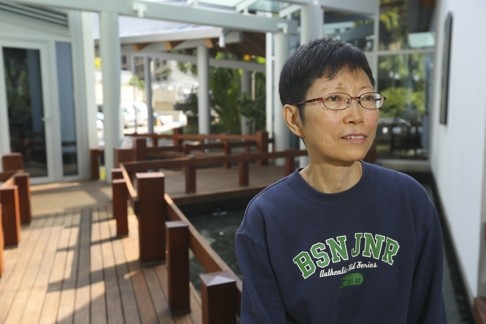
Cheung has negotiated the labyrinth many times since, and each time the feelings of being enveloped in safety and comfort returned.
Her attitude is a complete change from the gloom that enshrouded her when she first came to the centre in 2009.
“I didn’t want to talk to people, I was negative, always wondering why things were happening to me,” she recalls. “But after walking the labyrinth and doing meditation, I am now thankful for cancer for changing me. I don’t feel sorry for myself and now I am at my happiest, appreciative of life. My change in attitude has rubbed off on my family members, too.”
Centre manager Helen Lui Wong Yun-fong says having the labyrinth is in line with the centre’s aim of creating an environment that empowers cancer patients to take a more active role. This instils a positive attitude that helps them better deal with their treatments because they are psychologically stronger.
The exercise helps cancer patients look at life with a different perspective, Lui says. “The sharp turns within the labyrinth may seem scary, but once you make the turn, you can see the path ahead of you.”
Lui, too, paces through the labyrinth whenever she feels stressed, or is looking to find perspective on a problem as the activity helps her calm down and think logically of a solution.
As patients at the local Maggie’s centre have clearly benefited from the use, Lui is keen to have Collard build a new labyrinth as soon as they have secured a site nearby.
“If you have a concern, walking the labyrinth will help you find a way out. It helps you develop a positive attitude and persistence,” Lui says. “If you believe and continue pressing on, everything will be OK.”
Labyrinths in public places
St John’s Cathedral, 4-8 Garden Road, Central
Tao Fong Shan Christian Centre, 33 Tao Fong Shan Road, Sha Tin
Star Ferry, Central (G/F, near Pier 9)
The Providence Garden for Rehab, 82 Tsun Wen Road, Tuen Mun
From January 18, Martha Collard will facilitate labyrinth walks at the one at the Star Ferry.